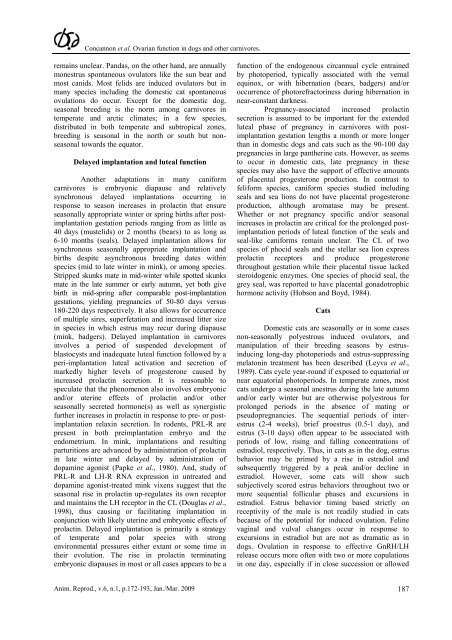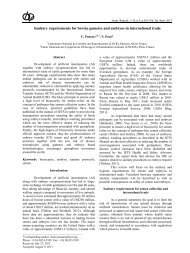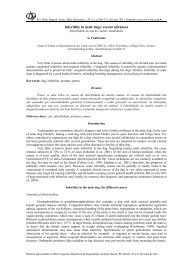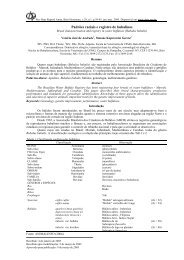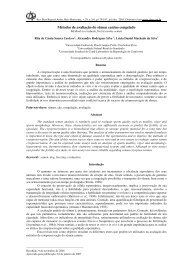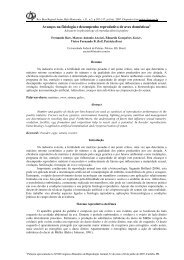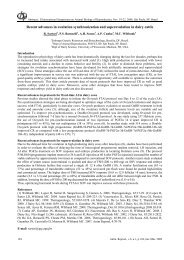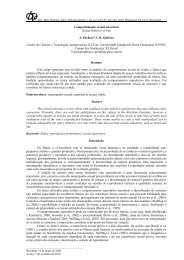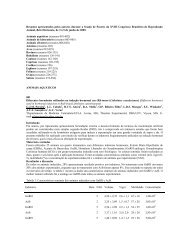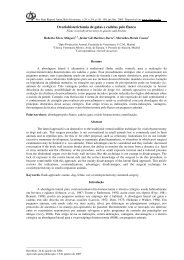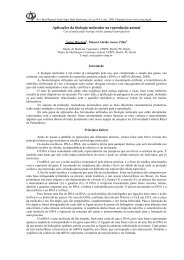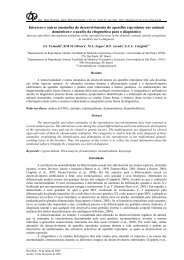Endocrine control of ovarian function in dogs and other carnivores
Endocrine control of ovarian function in dogs and other carnivores
Endocrine control of ovarian function in dogs and other carnivores
Create successful ePaper yourself
Turn your PDF publications into a flip-book with our unique Google optimized e-Paper software.
Concannon et al. Ovarian <strong>function</strong> <strong>in</strong> <strong>dogs</strong> <strong>and</strong> <strong>other</strong> <strong>carnivores</strong>.<br />
rema<strong>in</strong>s unclear. P<strong>and</strong>as, on the <strong>other</strong> h<strong>and</strong>, are annually<br />
monestrus spontaneous ovulators like the sun bear <strong>and</strong><br />
most canids. Most felids are <strong>in</strong>duced ovulators but <strong>in</strong><br />
many species <strong>in</strong>clud<strong>in</strong>g the domestic cat spontaneous<br />
ovulations do occur. Except for the domestic dog,<br />
seasonal breed<strong>in</strong>g is the norm among <strong>carnivores</strong> <strong>in</strong><br />
temperate <strong>and</strong> arctic climates; <strong>in</strong> a few species,<br />
distributed <strong>in</strong> both temperate <strong>and</strong> subtropical zones,<br />
breed<strong>in</strong>g is seasonal <strong>in</strong> the north or south but nonseasonal<br />
towards the equator.<br />
Delayed implantation <strong>and</strong> luteal <strong>function</strong><br />
An<strong>other</strong> adaptations <strong>in</strong> many caniform<br />
<strong>carnivores</strong> is embryonic diapause <strong>and</strong> relatively<br />
synchronous delayed implantations occurr<strong>in</strong>g <strong>in</strong><br />
response to season <strong>in</strong>creases <strong>in</strong> prolact<strong>in</strong> that ensure<br />
seasonally appropriate w<strong>in</strong>ter or spr<strong>in</strong>g births after postimplantation<br />
gestation periods rang<strong>in</strong>g from as little as<br />
40 days (mustelids) or 2 months (bears) to as long as<br />
6-10 months (seals). Delayed implantation allows for<br />
synchronous seasonally appropriate implantation <strong>and</strong><br />
births despite asynchronous breed<strong>in</strong>g dates with<strong>in</strong><br />
species (mid to late w<strong>in</strong>ter <strong>in</strong> m<strong>in</strong>k), or among species.<br />
Stripped skunks mate <strong>in</strong> mid-w<strong>in</strong>ter while spotted skunks<br />
mate <strong>in</strong> the late summer or early autumn, yet both give<br />
birth <strong>in</strong> mid-spr<strong>in</strong>g after comparable post-implantation<br />
gestations, yield<strong>in</strong>g pregnancies <strong>of</strong> 50-80 days versus<br />
180-220 days respectively. It also allows for occurrence<br />
<strong>of</strong> multiple sires, superfetation <strong>and</strong> <strong>in</strong>creased litter size<br />
<strong>in</strong> species <strong>in</strong> which estrus may recur dur<strong>in</strong>g diapause<br />
(m<strong>in</strong>k, badgers). Delayed implantation <strong>in</strong> <strong>carnivores</strong><br />
<strong>in</strong>volves a period <strong>of</strong> suspended development <strong>of</strong><br />
blastocysts <strong>and</strong> <strong>in</strong>adequate luteal <strong>function</strong> followed by a<br />
peri-implantation luteal activation <strong>and</strong> secretion <strong>of</strong><br />
markedly higher levels <strong>of</strong> progesterone caused by<br />
<strong>in</strong>creased prolact<strong>in</strong> secretion. It is reasonable to<br />
speculate that the phenomenon also <strong>in</strong>volves embryonic<br />
<strong>and</strong>/or uter<strong>in</strong>e effects <strong>of</strong> prolact<strong>in</strong> <strong>and</strong>/or <strong>other</strong><br />
seasonally secreted hormone(s) as well as synergistic<br />
further <strong>in</strong>creases <strong>in</strong> prolact<strong>in</strong> <strong>in</strong> response to pre- or postimplantation<br />
relax<strong>in</strong> secretion. In rodents, PRL-R are<br />
present <strong>in</strong> both preimplantation embryo <strong>and</strong> the<br />
endometrium. In m<strong>in</strong>k, implantations <strong>and</strong> result<strong>in</strong>g<br />
parturitions are advanced by adm<strong>in</strong>istration <strong>of</strong> prolact<strong>in</strong><br />
<strong>in</strong> late w<strong>in</strong>ter <strong>and</strong> delayed by adm<strong>in</strong>istration <strong>of</strong><br />
dopam<strong>in</strong>e agonist (Papke et al., 1980). And, study <strong>of</strong><br />
PRL-R <strong>and</strong> LH-R RNA expression <strong>in</strong> untreated <strong>and</strong><br />
dopam<strong>in</strong>e agonist-treated m<strong>in</strong>k vixens suggest that the<br />
seasonal rise <strong>in</strong> prolact<strong>in</strong> up-regulates its own receptor<br />
<strong>and</strong> ma<strong>in</strong>ta<strong>in</strong>s the LH receptor <strong>in</strong> the CL (Douglas et al.,<br />
1998), thus caus<strong>in</strong>g or facilitat<strong>in</strong>g implantation <strong>in</strong><br />
conjunction with likely uter<strong>in</strong>e <strong>and</strong> embryonic effects <strong>of</strong><br />
prolact<strong>in</strong>. Delayed implantation is primarily a strategy<br />
<strong>of</strong> temperate <strong>and</strong> polar species with strong<br />
environmental pressures either extant or some time <strong>in</strong><br />
their evolution. The rise <strong>in</strong> prolact<strong>in</strong> term<strong>in</strong>at<strong>in</strong>g<br />
embryonic diapauses <strong>in</strong> most or all cases appears to be a<br />
<strong>function</strong> <strong>of</strong> the endogenous circannual cycle entra<strong>in</strong>ed<br />
by photoperiod, typically associated with the vernal<br />
equ<strong>in</strong>ox, or with hibernation (bears, badgers) <strong>and</strong>/or<br />
occurrence <strong>of</strong> photorefractor<strong>in</strong>ess dur<strong>in</strong>g hibernation <strong>in</strong><br />
near-constant darkness.<br />
Pregnancy-associated <strong>in</strong>creased prolact<strong>in</strong><br />
secretion is assumed to be important for the extended<br />
luteal phase <strong>of</strong> pregnancy <strong>in</strong> <strong>carnivores</strong> with postimplantation<br />
gestation lengths a month or more longer<br />
than <strong>in</strong> domestic <strong>dogs</strong> <strong>and</strong> cats such as the 90-100 day<br />
pregnancies <strong>in</strong> large panther<strong>in</strong>e cats. However, as seems<br />
to occur <strong>in</strong> domestic cats, late pregnancy <strong>in</strong> these<br />
species may also have the support <strong>of</strong> effective amounts<br />
<strong>of</strong> placental progesterone production. In contrast to<br />
feliform species, caniform species studied <strong>in</strong>clud<strong>in</strong>g<br />
seals <strong>and</strong> sea lions do not have placental progesterone<br />
production, although aromatase may be present.<br />
Whether or not pregnancy specific <strong>and</strong>/or seasonal<br />
<strong>in</strong>creases <strong>in</strong> prolact<strong>in</strong> are critical for the prolonged postimplantation<br />
periods <strong>of</strong> luteal <strong>function</strong> <strong>of</strong> the seals <strong>and</strong><br />
seal-like caniforms rema<strong>in</strong> unclear. The CL <strong>of</strong> two<br />
species <strong>of</strong> phocid seals <strong>and</strong> the stellar sea lion express<br />
prolact<strong>in</strong> receptors <strong>and</strong> produce progesterone<br />
throughout gestation while their placental tissue lacked<br />
steroidogenic enzymes. One species <strong>of</strong> phocid seal, the<br />
grey seal, was reported to have placental gonadotrophic<br />
hormone activity (Hobson <strong>and</strong> Boyd, 1984).<br />
Anim. Reprod., v.6, n.1, p.172-193, Jan./Mar. 2009 187<br />
Cats<br />
Domestic cats are seasonally or <strong>in</strong> some cases<br />
non-seasonally polyestrous <strong>in</strong>duced ovulators, <strong>and</strong><br />
manipulation <strong>of</strong> their breed<strong>in</strong>g seasons by estrus<strong>in</strong>duc<strong>in</strong>g<br />
long-day photoperiods <strong>and</strong> estrus-suppress<strong>in</strong>g<br />
melaton<strong>in</strong> treatment has been described (Leyva et al.,<br />
1989). Cats cycle year-round if exposed to equatorial or<br />
near equatorial photoperiods. In temperate zones, most<br />
cats undergo a seasonal anestrus dur<strong>in</strong>g the late autumn<br />
<strong>and</strong>/or early w<strong>in</strong>ter but are <strong>other</strong>wise polyestrous for<br />
prolonged periods <strong>in</strong> the absence <strong>of</strong> mat<strong>in</strong>g or<br />
pseudopregnancies. The sequential periods <strong>of</strong> <strong>in</strong>terestrus<br />
(2-4 weeks), brief proestrus (0.5-1 day), <strong>and</strong><br />
estrus (3-10 days) <strong>of</strong>ten appear to be associated with<br />
periods <strong>of</strong> low, ris<strong>in</strong>g <strong>and</strong> fall<strong>in</strong>g concentrations <strong>of</strong><br />
estradiol, respectively. Thus, <strong>in</strong> cats as <strong>in</strong> the dog, estrus<br />
behavior may be primed by a rise <strong>in</strong> estradiol <strong>and</strong><br />
subsequently triggered by a peak <strong>and</strong>/or decl<strong>in</strong>e <strong>in</strong><br />
estradiol. However, some cats will show such<br />
subjectively scored estrus behaviors throughout two or<br />
more sequential follicular phases <strong>and</strong> excursions <strong>in</strong><br />
estradiol. Estrus behavior tim<strong>in</strong>g based strictly on<br />
receptivity <strong>of</strong> the male is not readily studied <strong>in</strong> cats<br />
because <strong>of</strong> the potential for <strong>in</strong>duced ovulation. Fel<strong>in</strong>e<br />
vag<strong>in</strong>al <strong>and</strong> vulval changes occur <strong>in</strong> response to<br />
excursions <strong>in</strong> estradiol but are not as dramatic as <strong>in</strong><br />
<strong>dogs</strong>. Ovulation <strong>in</strong> response to effective GnRH/LH<br />
release occurs more <strong>of</strong>ten with two or more copulations<br />
<strong>in</strong> one day, especially if <strong>in</strong> close succession or allowed


